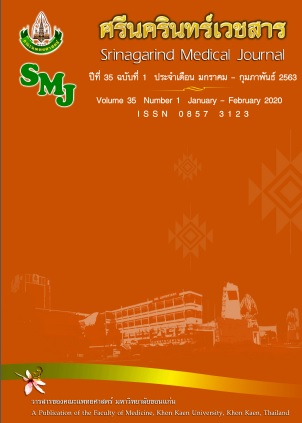Prevalence of Clinical Lumbar Instability in Patients with Chronic Low Back Pain by Radiography (Pilot Study)
Keywords:
Prevalence, Low back pain, lumbar instability, , X-ray, ความชุก, ปวดหลังส่วนล่าง, ความไม่มั่นคงของกระดูกสันหลัง, เอ็กซเรย์Abstract
ความชุกของภาวะหลังหลวมที่มีอาการทางคลินิกโดยตรวจจากการถ่ายภาพเอ็กซเรย์ (การศึกษานำร่อง)
อริสา เหลืองบุตรนาค1,2, รุ้งทิพย์ พันธุเมธากุล1,2*, ทวีศักดิ์ จรรยาเจริญ1,2, วัณทนา ศิริธราธิวัตร1,2,สุรชัย แซ่จึง3
1สาขาวิชากายภาพบาบัด คณะเทคนิคการแพทย์ มหาวิทยาลัยขอนแก่น
2ศูนย์วิจัยปวดหลัง ปวดคอ ปวดข้ออื่นๆ และสมรรถนะของมนุษย์ (BNOJPH) คณะเทคนิคการแพทย์ มหาวิทยาลัยขอนแก่น
3คณะแพทยศาสตร์ มหาวิทยาลัยขอนแก่น
หลักการและวัตถุประสงค์: ภาวะหลังหลวมแบ่งออกเป็นหลายประเภท แต่ประเภทที่ส่งผลต่อผู้ป่วยคือภาวะหลังหลวมที่มีอาการทางคลินิก (clinical lumbar instability) ที่พบการเคลื่อนและการหมุนของกระดูกสันหลังระดับเอวมากกว่าค่าปกติร่วมกับมีอาการปวด และส่งผลเสียต่อผู้ป่วยในหลายด้าน อย่างไรก็ตามพบว่าการศึกษาก่อนหน้ามีความแตกต่างกันในส่วนของระเบียบวิธีวิจัย การศึกษานี้มีวัตถุประสงค์เพื่อศึกษาความชุกของภาวะหลังหลวมที่มีอาการทางคลินิกในผู้ที่มีอาการปวดหลังส่วนล่างเรื้อรังโดยตรวจด้วยการถ่ายภาพเอ็กซเรย์
วิธีการศึกษา: เป็นการศึกษาเชิงพรรณนาแบบตัดขวางในอาสาสมัครที่มีอาการปวดหลังเรื้อรังจำนวน 50 รายที่มีอายุเฉลี่ย 33.7±13.3 ปี โดยการสอบถามข้อมูลพื้นฐานและถ่ายภาพเอ็กซเรย์ในขณะที่ผู้ป่วยก้มตัวสุดและแอ่นตัวสุดเพื่อวินิจฉัยภาวะหลังหลวม จากนั้นวิเคราะห์ข้อมูลโดยใช้สถิติเชิงพรรณนา
ผลการศึกษา: พบว่ามีจำนวนของภาวะหลังหลวมที่มีอาการทางคลินิกเป็นร้อยละ 92 จากอาสาสมัครทั้งหมดที่มีช่วงอายุระหว่าง 20-59 ปี โดยที่ช่วงอายุ 30-39 และ 50-59 ปีพบว่ามีความชุกของภาวะหลังหลวมที่มีอาการทางคลินิกร้อยละ 100 ส่วนช่วงอายุ 20-29 และ 40-49 ปีพบว่ามีความชุกร้อยละ 93.3 และ 66.7 ตามลำดับ
สรุป: ภาวะหลังหลวมที่มีอาการทางคลินิกสามารถพบได้ในผู้ป่วยที่ปวดหลังส่วนล่างเรื้อรังตั้งแต่อายุ 20 ปีขึ้นไป ดังนั้นการตระหนักถึงความสำคัญของการประเมินภาวะดังกล่าวในคนที่มีอายุน้อยจึงมีความสำคัญ เพื่อการวางแผนการรักษาในระยะแรกเริ่มอย่างเหมาะสม
which Clinical Lumbar Instability (CLI) was considered as affected on patients. CLI defined as the translation and rotation values of each lumbar segment greater than normal translation and rotation with clinical sign. CLI could result in patients in many aspects which had been reported. However, the evidence on reporting of lumbar instability have different methodology. The aimed of this study was to report CLI in patients with chronic low back pain by radiography.
Methods: This was a cross-sectional descriptive study in 50 chronic low back pain (CLBP) participants aged 33.7±13.3 years. Data were collected by interview for demographic data and flexion-extension radiograph for diagnosis instability. Descriptive statistics were used for calculation.
Results: This study found that the amount of CLI was 92%. Age of participants with CLI range from 20-59, which the participant aged 30 to 39 and 50 to 59 years showed 100% of CLI, aged 20 to 29 and 40 to 49 years showed 93.3% and 66.7%, respectively.
Conclusions: The finding of prevalence, age, and LBP period in this study demonstrated that CLI could be occurred in people who aged from 20 years onward. There were young patients with CLBP, the practitioner should aware of assessment about CLI in order to providing suitable management.
References
Woolf AD, Pfleger B. Burden of major musculoskeletal conditions. Bull World Health Organ 2003; 81: 646-56.
Deyo RA, Weinstein JN. Low back pain. N Engl J Med 2001; 344: 363-70. Review.
Vanti C, Conti C, Feresin F, Ferrari S, Piccarreta R. The relationship between clinical instability and endurance test, pain, and disability in nonspecific low back pain. J Manipulative Physiol Ther 2016; 39: 359-68.
Panjabi MM. The stabilizing system of the spine. Part II. Neutral zone and instability hypothesis. J Spinal Disord 1992; 5: 390-6.
Abbott JH, McCane B, Herbison P, Moginie G, Chapple C, Hogarty T. Lumbar segmental instability: a criterion-related validity study of manual therapy assessment. BMC Musculoskelet Disord 2005; 6: 56.
Panjabi MM. The stabilizing system of the spine. Part I. Function, dysfunction, adaptation, and enhancement. J Spinal Disord 1992; 5: 383-9.
รุ้งทิพย์ พันธุเมธากุล. กายภาพบำบัดในภาวะหลังส่วนล่างหลวม. พิมพ์ครั้งที่ 1. ขอนแก่น: คณะเทคนิคการแพทย์ มหาวิทยาลัยขอนแก่น, 2561.
Cook C, Brismée JM, Sizer PS Jr. Subjective and objective descriptors of clinical lumbar spine instability: a Delphi study. Man Ther 2006; 11: 11-21.
Fritz JM, Piva SR, and Childa JD. Accuracy of the clinical examination to predict radiologic instability of the lumbar spine. Eur Spine J 2005; 14: 743-50.
Iguchi T, Kanemura A, Kasahara K, Kurihara A, Doita M, Yoshiya S. Age distribution of three radiologic factors for lumbar instability: probable aging process of the instability with disc degeneration. Spine (Phila Pa 1976) 2003; 28: 2628-33.
White AA, Panjabi MM. Clinical biomechanics of the spine, 2nd edition. Lippincott, Philadelphia, 1990; 23–45.
Staub BN, Holman PJ, Reitman CA, Hipp J. Sagittal plane lumbar intervertebral motion during seated flexion-extension radiographs of 658 asymptomatic nondegenerated levels. J Neurosurg Spine 2015; 23: 731-8.
Puntumetakul R, Yodchaisarn W, Emasithi A, Keawduangdee P, Chatchawan U, Yamauchi J. Prevalence and individual risk factors associated with clinical lumbar instability in rice farmers with low back pain. Patient Prefer Adherence 2014; 9: 1-7.
Puntumetakul R, Trott P, Williams M, Fulton I. Effect of time of day on the vertical spinal creep response. Appl Ergon 2009; 40: 33-8.
Faucett J. Chronic low back pain: early interventions. Annu Rev Nurs Res 1999; 17: 155-82.


